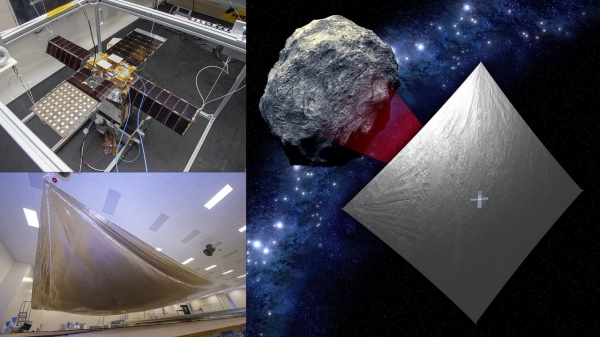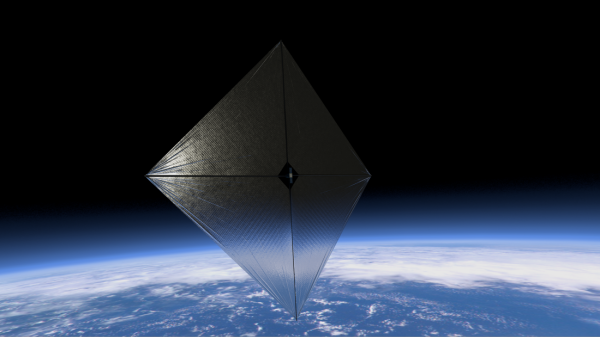2020 GE is an interesting, and soon to be useful, near-Earth asteroid. Discovered in March of 2020 through the University of Arizona’s Catalina Sky Survey, 2020 GE is small, no more than 18 meters or so across, placing it in that class of asteroids below 100 meters in size that have not yet been examined up close by our spacecraft. Moreover, this NEA will, in September of 2023, obligingly make a close approach to the Earth, allowing scientists to get that detailed look through a mission called NEA Scout.
This is a mission we’ve looked at before, and I want to stay with it because of its use of a solar sail. Scheduled to be launched with the Artemis 1 test flight using the Space Launch System (SLS) rocket no earlier than March of this year, NEA Scout is constructed as a six-unit CubeSat, one that will be deployed by a dispenser attached to an adapter ring connecting the rocket with the Orion spacecraft. After separation, the craft will unfurl a sail of 86 square meters, deployed via stainless steel alloy booms. It is one of ten secondary payloads to be launched aboard the SLS on this mission.
Les Johnson is principal technology investigator for NEA Scout at Marshall Space Flight Center in Huntsville:
“The genesis of this project was a question: Can we really use a tiny spacecraft to do deep space missions and produce useful science at a low cost? This is a huge challenge. For asteroid characterization missions, there’s simply not enough room on a CubeSat for large propulsion systems and the fuel they require.”

Image: NEA Scout is composed of a small, shoebox-sized CubeSat (top left) and a thin, aluminum-coated solar sail about the size of a racquetball court (bottom left). After the spacecraft launches aboard Artemis I, the sail will use sunlight to propel the CubeSat to a small asteroid (as depicted in the illustration, right). Credit: NASA.
A solar sail ought to be made to order if the objective is eventual high performance within the constraints of low mass and low volume. Reflecting solar photons and also using small cold-gas thrusters for maneuvers and orientation, NEA Scout will be investigating a near-Earth asteroid in a size range that is far more common than the larger NEAs we’ve thus far studied. It’s worth remembering that the Chelyabinsk impactor was about 20 meters in diameter, and in the same class as 2020 GE.
The 2023 close approach to Earth will occur at a time when NEA Scout will have used a gravitational assist from the Moon to alter its trajectory to approach the asteroid. Julie Castillo-Rogez, the mission’s principal science investigator at JPL, says that the spacecraft will achieve a slow flyby with relative speed of less than 30 meters per second. Using a camera with a resolution of 10 centimeters per pixel, scientists should be able to learn much about the object’s composition – a clump of boulders and dust (think Bennu, as investigated by OSIRIS-REx), or a solid object more like a boulder?
Bear in mind that NEA Scout fits into a continuum of solar sail development, with NASA’s Advanced Composite Solar Sail System (ACS3) the next to launch, demonstrating new, lightweight boom deployment techniques from a CubeSat. The unfurled square sail will be approximately 9 meters per side. As we haven’t looked at this one before, let me add this, from a NASA fact sheet:
The ACS3’s sails are supported and connected to the spacecraft by booms, which function much like a sailboat’s boom that connects to its mast and keeps the sail taut. The composite booms are made from a polymer material that is flexible and reinforced with carbon fiber. This composite material can be rolled for compact stowage, but remains strong and lightweight when unrolled. It is also very stiff and resistant to bending and warping due to changes in temperature. Solar sails can operate indefinitely, limited only by the space environment durability of the solar sail materials and spacecraft electronic systems. The ACS3 technology demonstration will also test an innovative tape-spool boom extraction system designed to minimize jamming of the coiled booms during deployment.

Image: An illustration of a completely unfurled solar sail measuring approximately 9 meters per side. Since solar radiation pressure is small, the solar sail must be large to efficiently generate thrust. Credit: NASA.
ACS3 is scheduled for liftoff later in 2022 as part of a rideshare mission on Rocket Lab’s Electron launch vehicle from its Launch Complex 1 in New Zealand. Beyond ACS3 looms Solar Cruiser, which takes the sail size up to 1,700 square meters in 2025, a mission we’ve looked at before and will continue to track as NASA attempts to launch the largest sail ever tested in space.



It is so pleasing to see that these solar sails are being both tested in space and deployed for real missions. I gather that orientation is still using thrusters rather than the original ideas of using small sails at the end of the booms to orientate the sails or JAXA’s elegant solution for IKAROS using strips of variable reflectance material on the sail.
The main issue for me is designing and launching larger sails, and reducing the sail material aerial density, so that sail performance increases, and with it, larger science payloads can be carried. Kept in the inner solar system, solar power can keep these craft useful for decades until consumables are fully depleted and instrument failure renders the craft useless. As we have seen with the Voyager probes, that might be many decades.
And all I ask is a tall ship and a star to steer her by… John Masefield
Aaargh! Me fancies the turn o’ her bilge, matey!…Foulweather Jack.
Nice application of Masefield there… and once again, something old is new again! “… a tall ship and a star to steer her by…”. Here is the rebirthing (recycling, anyway) of poetry. Poetry plus “re-poetry”. Good Lord… “re-poetry” !!! There’s a concept to work with! I mean… people have repeated lines from earlier works more often than can be counted… but fitting old lines into totally new contexts could be “new-dimensional” if done properly.
Immediately coming to mind are the frequent “re-tread” plus “re-mix” recordings heard on the radio, but I’m trying to think past that. need some time to work with this…
j
Wonderful to have you here, old friend!
The possibility of crewed voyages using solar sails evokes Edgar Allen Poe’s tale, Into the Maelstrom, of the terror of being drawn down to near destruction at sea and its parallel of being drawn into a gravity well to an even more certain destruction. Also, one of my favorite books from my youth, Two Years Before the Mast by Richard Dana. Hopefully voyages in space will someday inspire writers of similar quality in addition to the great science fiction writers of the past.
Good grief, have I uncovered another Richard Dana fan? What a book Two Years Before the Mast is! You’ve called up very good memories.
The quote from Masefield’s poem was hardly original. It was uttered by James Kirk in both ST:TOS, and in one movie:
In 2268, James T. Kirk quoted from Sea-Fever to Leonard McCoy. (TOS: “The Ultimate Computer”)
In 2287, Leonard McCoy confused Masefield with Herman Melville while on the shuttlecraft Galileo, but was quickly corrected by Spock. (Star Trek V: The Final Frontier)
– source Memory Alpha
However, I do think that given what a “tall ship” implies, a solar sail ship is more appropriate than the fictional starship Enterprise and will be even more so if solar sails are used for crewed spacecraft, like Diana in Clarke’s “The Wind from the Sun”, and a number of other scifi solar/beamed sail ships.
My sense is that solar sails are not suited for human crews as they are too slow. They evoke the same romance as sail ships (the best and only ocean transport before steam), and the airship (the economics make it a very poor choice for air travel). For low-cost non-perishable cargo, it may be a viable option in the solar system. Even if electric or magsails have better performance, they won’t evoke the same romance. Now beamed sails, OTOH, might work as fast ships for both crew and cargo if the economics proves favorable.
Yes, extremely useful future cargo haulers, I think, though the beamed sail offers much faster options. As does your Spacecoach, Alex (with a nod to co-author Brian McConnell). For those not familiar with the Spacecoach:
A Design for a Reusable Water-Based Spacecraft Known as the Spacecoach (SpringerBriefs in Space Development)
https://www.amazon.com/Water-Based-Spacecraft-Spacecoach-SpringerBriefs-Development-ebook/dp/B015F8T42Q/ref=sr_1_1?crid=230OOOTPUOO6F&keywords=spacecoach&qid=1643127645&s=books&sprefix=spacecoach%2Cstripbooks%2C612&sr=1-1
Whenever I watch that iconic scene in the Star Trek movies when the USS Enterprise, lying in space dock turns on her external lights and slowly and majestically leaves the dock to the stirring soundtrack, I also think of large solar sails, their booms slowly extending, their sails unfurling and starting to billow in the light of the sun.
There has always been something of the majesty and romance of large craft, stirring to life and being released into the medium of travel, whether ships on the open sea or airships into the sky.
Rocket launchers are awesome in their own way, fighting the bonds of gravity, but they don’t have the majesty of sea and airships. We don’t yet have huge spacecraft to evoke the same feelings, but solar sail craft might just bring that romance and majesty back. They will eventually become huge, at least visually. They will leave their spaceports slowly as sunlight accelerates them very gently away, just like the wind starting to push sailing ships as they unfurl their square-rigged sails, and airships slowly backing off from their mooring masts.
large, solar sailing ships will eventually dwarf the visual size of even the ISS, and be visible from the Earth’s surface and trackable for a long while with modest telescopes.
Clarke liked to quote a line from Tennyson’s Locksley Hall:
when he thought about the future for spacecraft and space commerce as analogous to the growth of 20th-century aviation.
May those “magic sails” refer to space sailing ships in the future.
As Clarke eloquently put it in Voices from the Sky – Ships for the Stars:
That ‘long result’ I used in the title of a recent post is also a nod to ‘Locksley Hall,’ an old favorite here:
“Many a night from yonder ivied casement, ere I went to rest,
Did I look on great Orion sloping slowly to the West.
“Many a night I saw the Pleiads, rising thro’ the mellow shade,
Glitter like a swarm of fire-flies tangled in a silver braid.
“Here about the beach I wander’d, nourishing a youth sublime
With the fairy tales of science, and the long result of Time…”